Jake Brown of Devon, England, has found a secret tunnel from 120 years ago, according to a report in the Mirror. He was standing outside near his basement door when he noticed that part of the wall had a different texture than the rest of it. He told reporters that he also noticed that the odd-looking patch was the same distance from the already-exposed coal cellar that was currently being used as storage space.
Since, like many other people around the world right now, Brown was bored at home on lockdown, he decided to take matters into his own hands and find out why. The results were unexpected surprise.
The first thing he did was drill a couple of holes into the wall so he could try to take a look inside. Putting a flashlight to one of the holes to act as a light source, he looked in the other hole to discover there was a cavern under the house.
Man discovers 120-year-old tunnel under his new house while bored in lockdown https://t.co/NAGEv0lWGv pic.twitter.com/PDFjZhGzPF
— Daily Mirror (@DailyMirror) May 5, 2020
The next obvious step in his investigation was to make a hole large enough that he could fit through, and see what was on the other side, so he got a hammer and got to work. Once he had a space opened that was large enough to get through, he and his flashlight discovered that not only was there a space, but that it was larger than he first expected. He found himself in a cavern that held a lot of what appeared to be construction waste from bygone years.
When he went into the space, it quickly became clear to him that the hole had been covered over for decades, and had most recently been used as place to conveniently dispose of refuse tied to having improvements made to the property in the past, such as having work done on the windows, roof, and gutters.
The man discovered a 120-year-old tunnel under his househttps://t.co/r3qxSR1SKN#tunnel #uk #discovery #technokidda #arshtechnologies #blog #bloggers #jamnagar_gujarat #jamnagar_instagram #jamnagari #jamnagardiaries #tuesday #tuesdaymotivation #tuesdaytips #tuesdaythoughts pic.twitter.com/ueg0wgUCYu
— Het Patel (@arshtechnology) May 19, 2020
Having time on his hands, and being both bored and curious, Brown decided to try to figure out just how old the space was and how long it had been closed up, so he started looking for clues.
Plymouth Live, a local news site, reported that Brown’s next tasks were both to gather items which he could potentially place in time, and also to make an examination of how stable the space was, in terms of its structural integrity. He was relieved to find that the ceiling was made of stone and arched, and was still reassuringly solid. He also determined that the space was about 3 m. high, 3 m wide, and about 15m deep.
While he was looking around he collected a number of items such as old bottles and paint cans that could help him figure out how old the space really was. His most potentially-useful find was an old newspaper, although it was badly degraded and whose pages were largely stuck together.
Wouldn’t it be great to find your very own tunnel under your house? Brilliant this…
Man finds secret 120-year-old tunnel filled with relics under his house https://t.co/lvltQzsxP1 via @MetroUK
— Williamson’s Tunnels (@FoWT) May 6, 2020
He hauled his finds into the light of day and discovered that the paint cans had labels of a style that was common in the 1950s and ‘60s, and that the bottles had etching of a type that was common in the first years of the last century. The newspaper was a harder nut to crack, since it had more or less solidified into a solid mass.
Using some creative thinking, Brown filled his tub with warm water and submerged it. After a while, he was able to separate parts of it using tweezers and vibrations. After he separated as much of it as he could, he took pictures of the pieces while they were still under water, then dried as many of them as he could salvage. Sifting through the contents of the paper, he eventually found a date which indicated that the paper was from 1964. The evidence he gathered suggested the cavern was around 120 years old, and had been sealed for over 50 of those years.
That night, Brown contacted Richard Fisher, a local historian. Fisher told Brown that his property was of a type known as a ‘John Foulston/George Whitwright’ house, and was from approximately 1835. During that period, the homes in Brown’s neighborhood were built on what used to be hill, which had been quarried away nearly to the high-tide level.
Related Article: Incredible 17th Century Secret Passageway Found in British Parliament
The houses were built into the hole, and they were erected over undercrofts and cellars. Those cellars, usually meant for coal, were built out under the pavement, and even tunneled out under the road. Brown has expressed his interest in cleaning out his newly-discovered time capsule and possibly repurposing the space.
